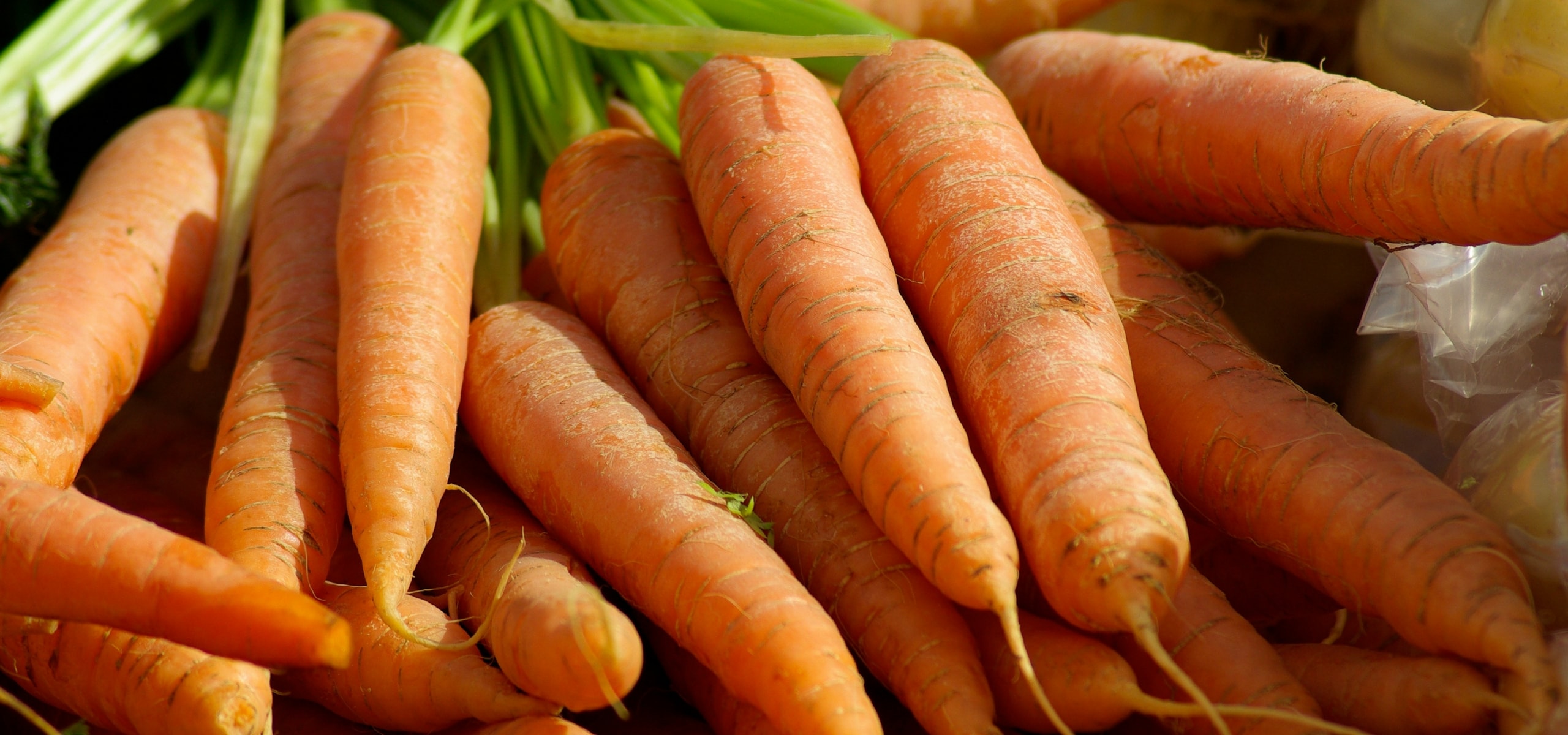
Carrot: sowing, growing, harvesting in the vegetable garden
Contents
Carrot in a nutshell
- Carrot thrives in deep, rich, and light soils as well as in sunny exposure.
- It comes in various varieties with different shapes and colours.
- Mastering sowing and thinning are the two main keys to successful carrots.
- Carrot pairs very well with radish and plants from the onion family.
- Harvesting is very simple, and they can be stored throughout winter.
A word from our expert
Carrot is a root vegetable widely grown and consumed in France and around the world, but it is not always present in vegetable gardens as tomatoes are. However, the flavour of this famous root often bears little resemblance to that found in shops when it is nurtured by our care. Moreover, the vast variety available allows for delightful taste discoveries.
Carrots come in various shapes, colours, and sizes. Among the most well-known is the ‘Nantaise’ carrot, renowned for its flavour and ease of cultivation, its only requirement being light soil for proper development. Grelot carrots like ‘Marché de Paris’ are also very interesting for their taste quality. Colourful varieties such as ‘Cosmic Purple’ or ‘Blanche de Küttingen’ will add a unique touch to your favourite dishes.
Carrot cultivation takes place throughout France; one simply needs to find the variety or varieties best suited to their region and soil. In terms of preferences, a loose and deep, light and rich soil will satisfy long and half-long carrots. Heavy soil will preferably accommodate grelot carrots.
Carrot sowing is done exclusively in situ, from spring to summer. The sowing should be quite sparse and closely monitored throughout the germination period. Thinning follows if the seedlings are too close to each other. Afterwards, maintenance consists of watering, weeding, and mulching while waiting for the harvest.

A beautiful diversity of varieties
Description and Botany
Botanical data
- Latin name Daucus carota subsp. sativus
- Family Apiaceae
- Common name Carrot
- Flowering Biennial cultivated as annual
- Height 4 to 5 years
- Exposure Sun
- Soil type Deep, rich, light
- Hardiness hardy to very hardy
Carrot, in its wild state, is a pioneering plant, native to Europe and South Asia, particularly Afghanistan. This root is not fleshy, its core is very fibrous and inedible, it is red to purple in colour. Humans have been interested in it since antiquity, initially for its aromatic properties, as its foliage emits a pleasant scent.
Over time, the carrot made its way to Europe, being domesticated from the Middle Ages for roots that were more fleshy, in white, yellow, and purple colours. It became a vegetable around the 13th century, but it was still fibrous. The carrot as we know it today, with its beautiful orange root, has a relatively recent origin in history.
The first selections of orange carrots were made in the Netherlands in the 16th century, resulting from cross-breeding between red and white carrots. The first orange carrot was called ‘Long Orange’. Its success was immediate, and breeders created many other varieties over the centuries, leading to the diversity we know today.
The cultivated carrot (Daucus carota subsp. sativus) is a biennial herbaceous plant from the Apiaceae family (formerly known as Umbelliferae). In the first year of cultivation, its bright green, finely divided, and pubescent foliage reaches about 30 cm in height. It is supported by multiple stems emerging from the collar. Its taproot, characteristic of the Apiaceae, is fleshy and varies in thickness and length, with skin and flesh colour varying according to the varieties. At the centre lies the core, which modern variety selection has made less fibrous. The carrot produces a flower stalk in the second year. It bears small white flowers grouped in umbels starting in June. This flowering is particularly attractive to pollinating insects. The seeds (achene) are rounded on one side and flat on the other, grouped in pairs and surrounded by hairs, allowing them to cling to the fur of animals for dispersal in nature.

Flowering of wild carrot – seed formation
Carrot varieties
Long carrots, such as ‘de Carentan’, are mainly suited for deep soils and autumn and winter harvests. Semi-long varieties, like ‘Touchon’, do not form a heart and can be harvested as early as June. In heavy and compact soil, it is preferable to opt for varieties known as semi-short, such as ‘de Chantenay’, or grelot varieties like ‘Marché de Paris’.
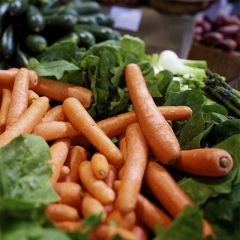
Organic Carrot Berlicum 2 - Ferme de Sainte Marthe seeds - Daucus carota
- Height at maturity 30 cm
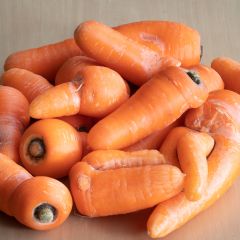
Carrot Caracas - Daucus carota
- Height at maturity 30 cm
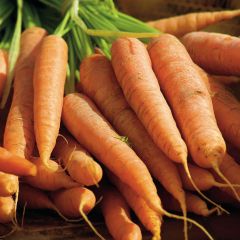
Carrot de Carentan
- Height at maturity 25 cm
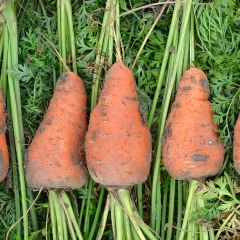
Carrot Chantenay à Coeur Rouge - Daucus carota
- Height at maturity 30 cm
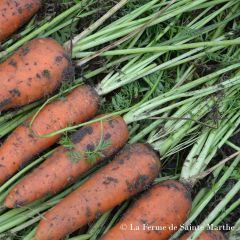
Carrot Autumn King 2 - Ferme de Sainte Marthe seeds
- Height at maturity 30 cm
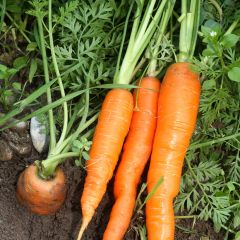
Carrot Nantes 2 - Ferme de Sainte Marthe Seeds
- Height at maturity 30 cm
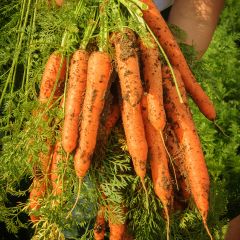
Carrot Touchon - Ferme de Sainte Marthe Seeds
- Height at maturity 20 cm
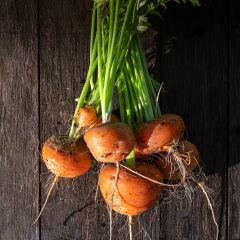
Carrot Paris Market
- Height at maturity 20 cm
Original carrots
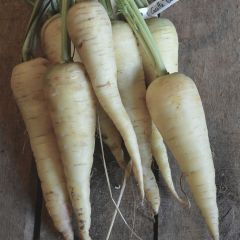
White Carrot Blanche de Küttingen - Ferme de Sainte Marthe Seeds
- Height at maturity 30 cm
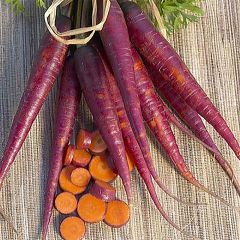
Carrot Cosmic Purple - Daucus carota
- Height at maturity 30 cm
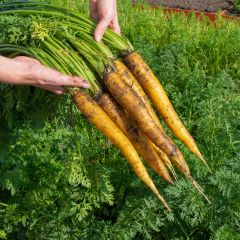
Carrot Jaune du Doubs - Ferme de Sainte Marthe untreated seeds
- Height at maturity 30 cm
Discover other Carrot seeds
View all →Available in 1 sizes
Available in 1 sizes
Available in 1 sizes
Available in 1 sizes
Available in 1 sizes
Available in 1 sizes
Available in 1 sizes
Available in 1 sizes
Available in 1 sizes
Available in 1 sizes
Sowing carrots
Where and when to sow your carrots?
Carrots are primarily sown directly in the ground. They thrive in deep, rich, and light soils and require a sunny location. If your soil is heavy and compact (clay), it is advisable to choose half-long and conical or round varieties.
Sowing takes place directly in situ from February to November, depending on the varieties and type of cultivation. Germination occurs at a minimum temperature of 7 °C. Each variety has an ideal sowing period: this information is indicated on the seed packet.
The sowing calendar for direct sowing, without protection, is as follows:
- In March-April-May (seasonal crop) for a harvest from July to September,
- In June-July (late-season crop) for a harvest from September to November.
In an unheated shelter (greenhouse, tunnel, or under cloches), sowing is done:
- In February-March (early crop) for a harvest in June-July
- In October-November (late crop) for a harvest in spring.
How to sow carrot seeds?
Sowing is done in well-prepared soil. It should be weeded, deeply loosened (with a broad fork), and then raked to achieve fine soil free of plant debris.
Sowing is carried out directly in place and in rows:
- Trace flat furrows 5 cm wide and 1 cm deep, spaced 25 cm apart,
- Sow thinly, possibly mixing the seeds with sand or dry coffee grounds,
- Cover with fine soil and then firm down with the back of the rake,
- Water gently, in a light spray, to avoid displacing the seeds.
- Keep the soil moist until germination!
After germination (which takes about 15 days), and when the plants are well developed, thin out to keep one plant every 5 to 7 centimetres.
When sown alongside radishes (simultaneous sowing in the same row), carrots are easier to sow, as radishes quickly mark the row and, after harvest, make space for the carrots. With the rows clearly marked, it is easier to weed between them without making damaging mistakes to the carrots.
If you are a beginner, consider using seed tapes: they are incredibly simple, as the seeds, enclosed in biodegradable paper, are pre-spaced. These tapes sometimes contain several varieties, and carrot seeds are often combined with radish seeds. To sow, simply bury it and water.
The false sowing technique is a simple and effective method to facilitate carrot cultivation, saving you weeding time. To learn all about the false sowing technique, visit the advice sheet: “False Sowing, an Effective Technique to Reduce Weeds”
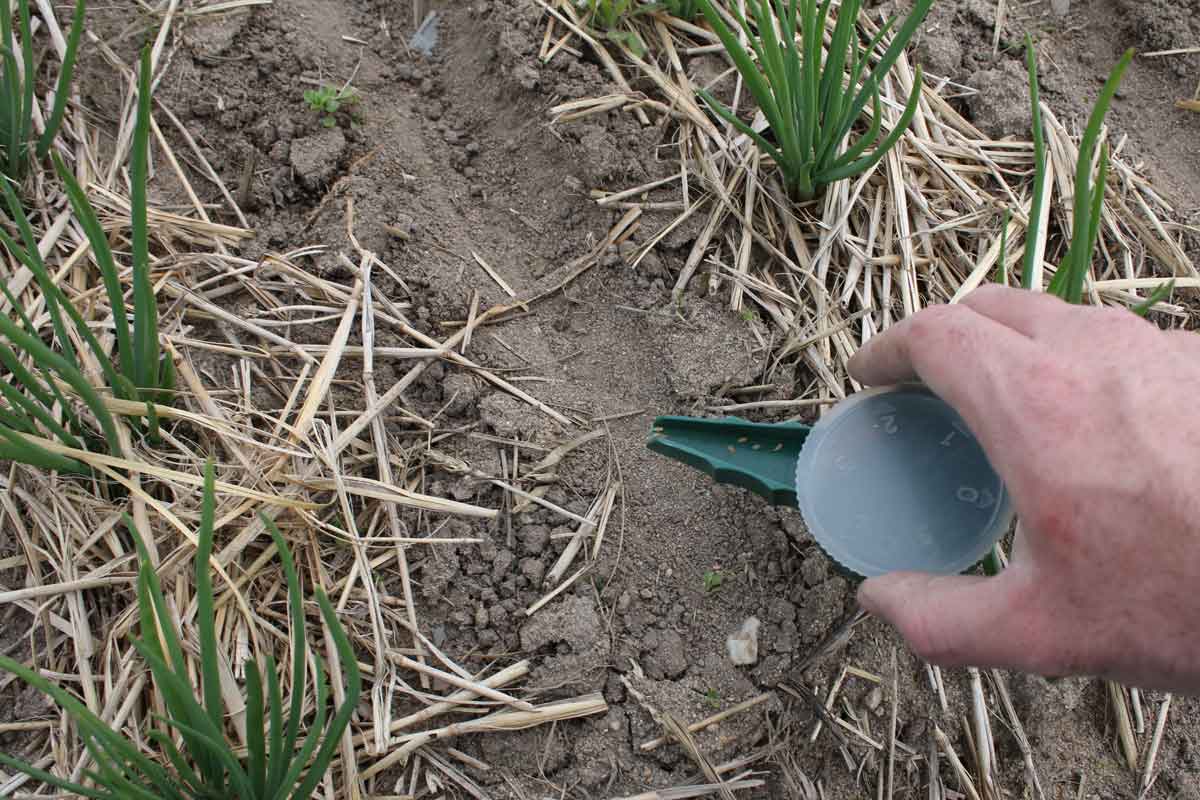
Sowing carrots between rows of shallots – see below for beneficial associations with carrots
Read also
Sowing vegetable seedsPairing carrots with the vegetable garden
Carrot pairs well with plants from the Amaryllidaceae family (formerly known as Alliacées), namely garlic, onion, leek, shallot, and spring onion. These well-known associations allow for the aromatic properties of each plant to deter pests from the other crop. Thus, Alliacées repel the carrot fly, and carrot repels the onion fly. Marigold, an essential flower in the vegetable garden, effectively enhances the repellent effect against the carrot fly.
Other beneficial associations include beetroot, lettuce, chilli, and radish, its favourite companion for sowing. As mentioned earlier, radish germinates quickly compared to carrot. Sowing these two plants at the same time and in the same rank allows for early marking of the row with the emergence of radishes, which facilitates weeding. Radish also breaks up any potential crust of compaction (a defect of certain soils) and thus aids in the emergence of carrots.
Avoid sowing carrots next to dill unless dill is sown sparingly in the row of carrots, for its repellent effect against the carrot fly. However, if dill is too present, it negatively affects the healthy growth of carrots (this is referred to as a negative allelopathic effect).
→ Read also the best companion plants for carrots

Carrots and beetroot appreciate each other in the vegetable garden.
Cultivation and care
Once the carrots have emerged, thinning is the most important operation for ensuring the success of the subsequent cultivation. Indeed, carrots that are too crowded will yield nothing; they need enough space to develop harmoniously. Initially, they can be thinned by leaving one carrot every 5 cm or so. Then, as they develop further, they are thinned a second time, removing every other one. At this stage, the thinned carrots are sufficiently fleshy to be consumed as mini-carrots!
Aside from thinning, carrots do not require specific maintenance, apart from regular hoeing and weeding. To limit these, we recommend mulching the soil. This way, you will reduce weeding while allowing the soil to retain its moisture. Watering can be spaced out, but it should be generous to prevent the roots from digging deep.
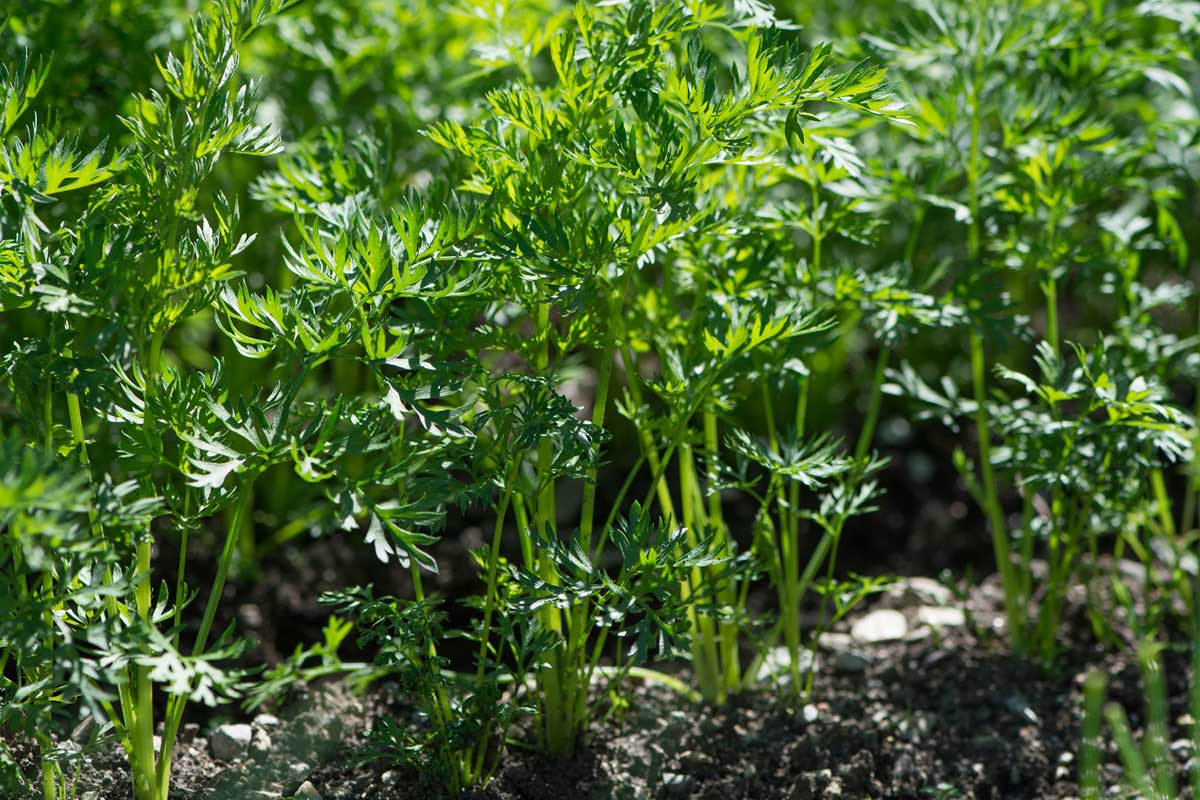
Diseases and Pests
Carrot fly
The main pest is the carrot fly, Psila Rosae. This parasitic insect, in its larval stage, burrows into the roots. It is present in gardens from April until early November.
Among all preventive measures, the installation of an insect net is the most effective. However, it can be accompanied or replaced, if you believe you are not in a high-risk area, by:
- associating with leek or onion,
- applying a mulch made of repellent plant waste (lavender, tansy),
- using a resistant variety such as ‘Resistofly F1’ or ‘Fly away F1’
Find additional advice in case of an attack by the carrot fly.
Alternaria
Alternaria is a fungal disease caused by Alternaria dauci. This disease manifests as brown spots that appear at the edges of the leaves and progress towards the centre of the lamina. These spots eventually dry out completely, limiting photosynthesis and subsequently the good growth of the roots. This is why, at the beginning of the growing season, this disease causes more significant damage. Alternaria can occur from spring to autumn and is favoured by temperatures of 22 to 25°C in humid weather.
Measures to apply in the garden:
- Remove diseased leaves or stems at the onset of the attack
- Remove affected carrots if the disease is more advanced
- Avoid watering the foliage if possible; for example, water at the neck of the watering can at soil level.
- In case of recurring attacks, use resistant varieties such as Boléro F1 (Vilmorin).
→ Learn more with our dedicated advice sheet: Diseases and pests of carrots
Harvesting and storing
Harvesting takes place 12 to 16 weeks after sowing, depending on the varieties and temperatures. It is done using a garden fork, taking care not to damage the roots, as this would affect their preservation. In regions with mild winters, carrots can overwinter in the ground. They will be protected from frost by a thick layer of dead leaves or straw, especially in the more continental areas.
A good method for winter preservation also involves storing them in a cellar, in sand. In autumn, the carrots are all lifted and cut at the collar. They are then stored in a box containing dry, fine sand.
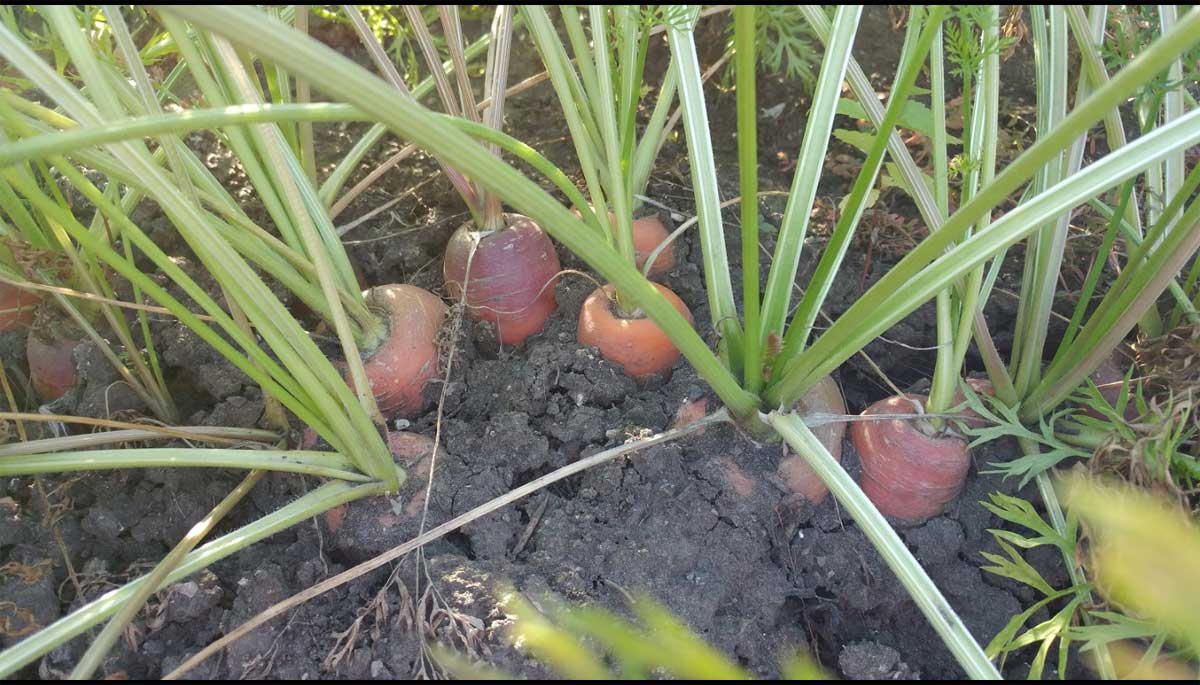
Carrots ready for harvest
→ Also discover Ingrid’s tips on lacto-fermentation preservation
Culinary uses and nutritional benefits
In the kitchen, carrots can be prepared in many ways and accompany numerous dishes, salads, or desserts. Grated, steamed, stewed in dishes, glazed, and even incorporated into tarts, jams, and sweet cakes, in short, there is no shortage of recipes that celebrate the carrot!
From a nutritional perspective, carrot is a vegetable known for being rich in carotin, antioxidant molecules that may slow down the ageing of cells and are beneficial for the eyes. It is also said to be rich in vitamins B9, C, and E, primarily located just beneath the skin, so it is advisable to scrub them well with a vegetable brush to retain the maximum amount of these vitamins. It is also rich in minerals, particularly magnesium and potassium, which contribute to a good regulation of blood pressure. Finally, carrot is well-known for giving a healthy glow to the skin!
→ Discover also zero waste cooking by recycling your carrot tops!
Making carrot seeds
Harvesting your own carrot seeds is not a very common practice among gardeners; however, it is not difficult, it is economical, and it allows you to adapt your favourite varieties to your growing conditions.
The first year of cultivation is identical to growing for consumption. In the autumn of this first year, the carrots are harvested and then stored in sand in a cellar or placed in a trench in the ground and covered with straw. The difference from harvesting for consumption is that the collar is retained, leaving about 2 cm of foliage. A selection of the finest carrots can be made at this time, discarding any roots that are too weak, have split, or show signs of carrot fly galleries.
In the second year, the carrots are replanted from February to April. They will flower in June, and the umbels will be ready to be harvested from August onwards. Harvest as the seeds reach ripeness by cutting the entire umbels and threshing them into a container. Choose a mesh sieve of 14 to separate the seeds from the beards.
Useful resources
Discover:
- Our wide range of carrots: in naked seeds or in tape
- Advice sheet: Choosing your carrots wisely: buying guide
- Advice sheet: Carrots, the best varieties
- Pascale explains how to make vegetable chips
- Advice sheet: Forage plants, 5 vegetables for animals
- Pascale tells you all about the best companion plants for carrots
- Gwenaëlle talks about the origins of carrots and other vegetables in Where do our favourite vegetables come from? Their history revealed.
Frequently asked questions
-
My carrots aren't germinating, why?
Possible reasons are numerous: - The most likely is a lack of water before germination. It is essential that the soil remains consistently moist between sowing and germination; a single watering on the day of sowing is not sufficient. - Your soil has formed a crust that prevents the seeds from emerging. To prevent crusting, watering should be as light as possible! In the long term, the soil should be protected and enriched with organic matter to gradually achieve a crumbly structure over the years. - Sowing carrots is generally more successful in May than in March, as the soil is warmer, allowing the seeds to germinate more quickly.
-
My carrots aren't growing, why?
Two possible reasons: - Carrots have not been sufficiently thinned; they are too close to each other. It is important to thin them at a young stage because even thinning at a later stage is already too late! - The second possibility concerns watering; it is good to water according to the size of the carrot, and the best way to determine this... is to check the soil! Especially in summer, check if the watering has been sufficient by checking the soil with a bulb planter (for example). If only the top 2 centimetres of the soil are moist and the carrot is already 10 cm long, it means that the watering is insufficient to reach the roots of the carrot. For proper watering of the carrot, water less frequently but abundantly.
- Subscribe!
- Contents
































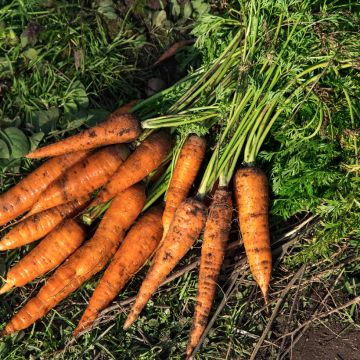
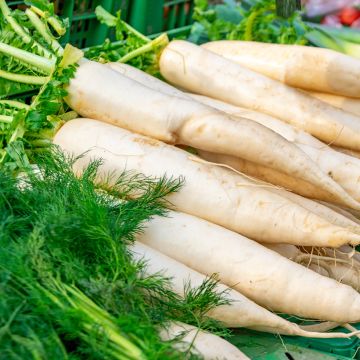
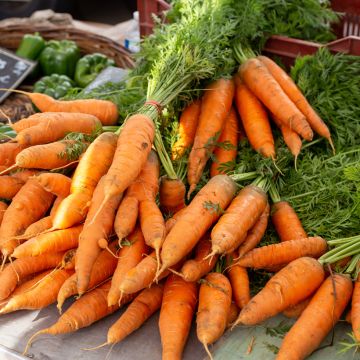
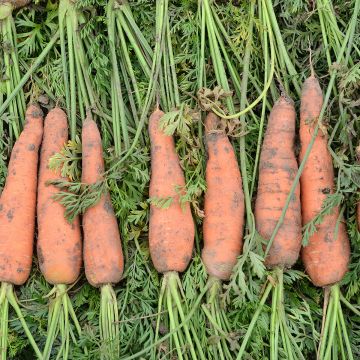
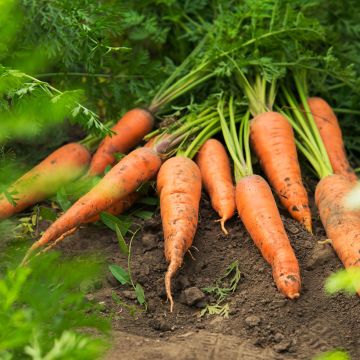

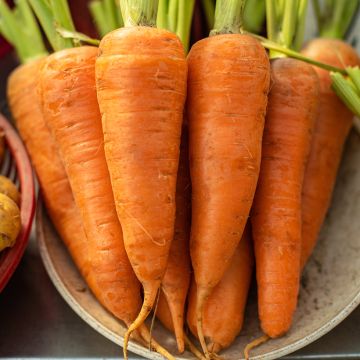
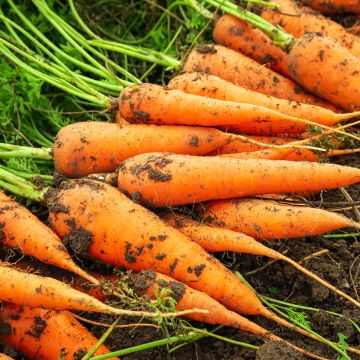
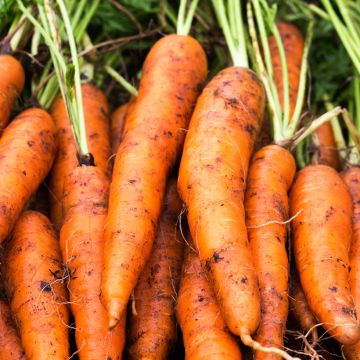
Comments